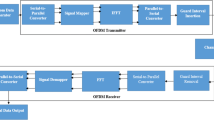Abstract
OFDM in high-speed wireless applications is an essential signal processing technique for the forthcoming decades due to its high-speed compatibility. The demand for high-speed applications increases due to availability of limited bandwidth source. Not only wired applications but also wireless applications usage increases day by day as emerging trends innovate new devices. These results in high data rate requirement and hence increase in number of sub-carriers. This creates issue with the peak-to-average power ratio (PAPR). The major challenge on such OFDM is to provide a better system performance by reducing the PAPR. Many reduction models are available in research market, such as selected map** and clip**. The proposed research model employs partial transmit sequence which uses phase factor along with a meta-heuristic optimization algorithm for improved results. This optimization provides low complex and fast convergence qualities with data classification, and it is better than nature-inspired optimization algorithms. Experiment results are compared, and it is observed that our proposed grey wolf optimization algorithm has better efficiency than the existing optimization algorithms.












Similar content being viewed by others
References
Al-Hussaini K, Ali BM, Varahram P, Hashim SJ, Farrell R (2016) Sub-blocks interleaving PTS technique with minimum processing time for PAPR reduction in OFDM systems. J Eng 1(5):134–140
Bao H, Fang J, Wan Q, Chen Z, Jiang T (2018) An ADMM approach for PAPR reduction for large-scale MIMO-OFDM systems. IEEE Trans Veh Technol 67(8):7407–7418
Beko M, Marikj M, Dinis R, Tuba M (2016) Peak-to-average power ratio reduction in multiple-input multiple-output orthogonal frequency-division multiple access systems using geodesic descent method. IET Commun 10(2):212–218
Fallahzadeh M, Ferdosizadeh M (2017) Blind SLM for PAPR reduction of Alamouti DSFBC systems. IET Commun 11(3):451–457
Hardas BM (2017) Optimization of peak to average power reduction in OFDM. J Commun Technol Electr 62(12):1388–1395
Hou J, Ge J, Gong F (2015) Tone reservation technique based on peak-windowing residual noise for PAPR reduction in OFDM systems. IEEE Trans Veh Technol 64(11):5373–5378
Hu W-W, Lee D-H (2017) PAPR reduction for visible light communication systems without side information. IEEE Photonics J 9(3):1–11
Kang C, Liu Y, Meixia H, Zhang H (2017) A low complexity PAPR reduction method based on FWFT and PEC for OFDM systems. IEEE Trans Broadcast 63(2):416–425
Khan MA, Rao RK (2016) Low-complexity PAPR reduction technique for OFDM systems using biased subcarriers. Can J Electr Comput Eng 39(1):19–25
Kim M, Lee W, Cho D-H (2018) A novel PAPR reduction scheme for OFDM system based on deep learning. IEEE Commun Lett 22(3):510–513
Li B, W X, Zhang H, Zhao C, Hanzo L (2017) PAPR reduction for hybrid ACO-OFDM aided IM/DD optical wireless vehicular communications. IEEE Trans Veh Technol 66(10):9561–9566
Liu A, Peng S, Song L, Liang X, Wang K, Zhang Q (2018) Peak-to-average power ratio of multicarrier faster-than-Nyquist signals: distribution, optimization and reduction. IEEE Access 6:11977–11987
Mazahir S, Sheikh SA (2016) On companding schemes for PAPR reduction in OFDM systems employing higher order QAM. IEEE Trans Broadcast 62(3):716–726
Mirjalili S, Mirjalili SM, Lewis A (2014) Grey wolf optimizer. Adv Eng Softw 69(12):46–61
Moon J-H, Nam Y-R, Kim J-H (2018) PAPR reduction in the FBMC-OQAM system via segment-based optimization. IEEE Access 6:4994–5002
Ogunkoya FB, Popoola WO, Shahrabi A, Sinanović S (2015) Performance evaluation of pilot-assisted PAPR reduction technique in optical OFDM systems. IEEE Photonics Technol Lett 27(10):1088–1091
Sandoval F, Poitau G, Gagnon F (2017) Hybrid peak-to-average power ratio reduction techniques: review and performance comparison. IEEE Access 5:27145–27161
Shrestha R, Kim JM, Seo J-S (2016) Enhanced phase realignment techniques for the PAPR reduction in OFDM systems. IEEE Trans Veh Technol 65(9):7173–7183
Sohn I, Kim SC (2015) Neural network based simplified clip** and filtering technique for PAPR reduction of OFDM signals. IEEE Commun Lett 19(8):1438–1441
Vittal MVR, Rama Naidu K (2017) A novel reduced complexity optimized PTS technique for PAPR reduction in wireless OFDM systems. Egypt Inform J 18(11):123–131
Wang Y, Akansu AN (2015) Low-complexity peak-to-average power ratio reduction method for orthogonal frequency-division multiplexing communications. IET Commun 9(17):2153–2159
Wang Y, Yang C, Ai B (2015) Iterative companding transform and filtering for reducing PAPR of OFDM signal. IEEE Trans Consum Electron 61(2):144–150
Wang S-H, Lin W-L, Huang B-R, Li C-P (2016) PAPR reduction in OFDM systems using active constellation extension and subcarrier grou** techniques. IEEE Commun Lett 20(12):2378–2381
Yoshizawa R, Ochiai H (2017) Energy efficiency improvement of coded OFDM systems based on PAPR reduction. IEEE Syst J 11(2):717–728
Zhang W, Zhang C, Chen C, ** W, Qiu K (2016) Joint PAPR reduction and physical layer security enhancement in OFDMA-PON. IEEE Photonics Technol Lett 28(9):998–1001
Zhao J, Ni S, Gong Y (2017) Peak-to-average power ratio reduction of FBMC/OQAM signal using a joint optimization scheme. IEEE Access 5:15810–15819
Zhou J, Qiao Y (2015) Low-PAPR asymmetrically clipped optical OFDM for intensity-modulation/direct-detection systems. IEEE Photonics J 7(3):7101608
Author information
Authors and Affiliations
Corresponding author
Ethics declarations
Conflict of interest
We have no conflict of interest with this research article.
Human and animal rights
We use no animal in this research.
Additional information
Communicated by P. Pandian.
Publisher’s Note
Springer Nature remains neutral with regard to jurisdictional claims in published maps and institutional affiliations.
Rights and permissions
About this article
Cite this article
Suriavel Rao, R.S., Malathi, P. A novel PTS: grey wolf optimizer-based PAPR reduction technique in OFDM scheme for high-speed wireless applications. Soft Comput 23, 2701–2712 (2019). https://doi.org/10.1007/s00500-018-3665-0
Published:
Issue Date:
DOI: https://doi.org/10.1007/s00500-018-3665-0




